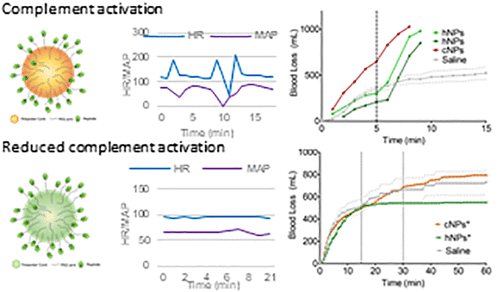当前位置:
X-MOL 学术
›
Bioconjugate Chem.
›
论文详情
Our official English website, www.x-mol.net, welcomes your feedback! (Note: you will need to create a separate account there.)
Engineering Intravenously Administered Nanoparticles to Reduce Infusion Reaction and Stop Bleeding in a Large Animal Model of Trauma.
Bioconjugate Chemistry ( IF 4.7 ) Pub Date : 2018-07-02 00:00:00 , DOI: 10.1021/acs.bioconjchem.8b00335 Chimdiya Onwukwe 1 , Nuzhat Maisha 1 , Mark Holland 1 , Matt Varley 2 , Rebecca Groynom 2 , DaShawn Hickman 2 , Nishant Uppal 3 , Andrew Shoffstall 2 , Jeffrey Ustin 2 , Erin Lavik 1
Bioconjugate Chemistry ( IF 4.7 ) Pub Date : 2018-07-02 00:00:00 , DOI: 10.1021/acs.bioconjchem.8b00335 Chimdiya Onwukwe 1 , Nuzhat Maisha 1 , Mark Holland 1 , Matt Varley 2 , Rebecca Groynom 2 , DaShawn Hickman 2 , Nishant Uppal 3 , Andrew Shoffstall 2 , Jeffrey Ustin 2 , Erin Lavik 1
Affiliation

|
Bleeding from traumatic injury is the leading cause of death for young people across the world, but interventions are lacking. While many agents have shown promise in small animal models, translating the work to large animal models has been exceptionally difficult in great part because of infusion-associated complement activation to nanomaterials that leads to cardiopulmonary complications. Unfortunately, this reaction is seen in at least 10% of the population. We developed intravenously infusible hemostatic nanoparticles that were effective in stopping bleeding and improving survival in rodent models of trauma. To translate this work, we developed a porcine liver injury model. Infusion of the first generation of hemostatic nanoparticles and controls 5 min after injury led to massive vasodilation and exsanguination even at extremely low doses. In naïve animals, the physiological changes were consistent with a complement-associated infusion reaction. By tailoring the zeta potential, we were able to engineer a second generation of hemostatic nanoparticles and controls that did not exhibit the complement response at low and moderate doses but did at the highest doses. These second-generation nanoparticles led to cessation of bleeding within 10 min of administration even though some signs of vasodilation were still seen. While the complement response is still a challenge, this work is extremely encouraging in that it demonstrates that when the infusion-associated complement response is managed, hemostatic nanoparticles are capable of rapidly stopping bleeding in a large animal model of trauma.
中文翻译:

在创伤的大型动物模型中,对静脉给药的纳米颗粒进行工程改造以减少输注反应并停止出血。
创伤造成的出血是全世界年轻人死亡的主要原因,但缺乏干预措施。尽管许多药物已在小型动物模型中显示出希望,但将工作转换为大型动物模型异常困难,这在很大程度上是由于与纳米材料相关的输注相关补体激活会导致心肺并发症。不幸的是,这种反应在至少10%的人口中可见。我们开发了静脉输注的止血纳米颗粒,可有效阻止啮齿类动物的出血并提高其存活率。为了翻译这项工作,我们开发了猪肝损伤模型。受伤后5分钟输注第一代止血纳米颗粒和对照,即使在极低剂量下也导致大量的血管舒张和放血。在幼稚的动物中,生理变化与补体相关的输注反应一致。通过调整zeta电位,我们能够设计出第二代止血纳米颗粒和对照,它们在低剂量和中剂量时不表现出补体反应,而在最高剂量时表现出。尽管仍观察到一些血管扩张的迹象,但这些第二代纳米颗粒可在给药后10分钟内导致出血停止。尽管补体应答仍然是一个挑战,但这项工作非常令人鼓舞,因为它表明,当管理与输液相关的补体应答时,止血纳米颗粒能够在大型创伤动物模型中快速止血。生理变化与补体相关的输注反应一致。通过调整zeta电位,我们能够设计出第二代止血纳米颗粒和质控品,它们在低剂量和中等剂量时不表现出补体反应,但在最高剂量时却表现出补体反应。尽管仍观察到一些血管扩张的迹象,但这些第二代纳米颗粒可在给药后10分钟内导致出血停止。尽管补体应答仍然是一个挑战,但这项工作非常令人鼓舞,因为它表明,当管理与输液相关的补体应答时,止血纳米颗粒能够在大型创伤动物模型中快速止血。生理变化与补体相关的输注反应一致。通过调整zeta电位,我们能够设计出第二代止血纳米颗粒和对照,它们在低剂量和中剂量时不表现出补体反应,而在最高剂量时表现出。尽管仍观察到一些血管扩张的迹象,但这些第二代纳米颗粒可在给药后10分钟内导致出血停止。尽管补体应答仍然是一个挑战,但这项工作非常令人鼓舞,因为它表明,当管理与输液相关的补体应答时,止血纳米颗粒能够在大型创伤动物模型中快速止血。我们能够设计出第二代止血纳米颗粒和对照,它们在低剂量和中等剂量时不表现出补体反应,而在最高剂量时却表现出补体反应。尽管仍观察到一些血管扩张的迹象,但这些第二代纳米颗粒可在给药后10分钟内导致出血停止。尽管补体应答仍然是一个挑战,但这项工作非常令人鼓舞,因为它表明,当管理与输液相关的补体应答时,止血纳米颗粒能够在大型创伤动物模型中快速止血。我们能够设计出第二代止血纳米颗粒和对照,它们在低剂量和中等剂量时不表现出补体反应,而在最高剂量时却表现出补体反应。尽管仍观察到一些血管扩张的迹象,但这些第二代纳米颗粒可在给药后10分钟内导致出血停止。尽管补体应答仍然是一个挑战,但这项工作非常令人鼓舞,因为它表明,当管理与输液相关的补体应答时,止血纳米颗粒能够在大型创伤动物模型中快速止血。尽管仍观察到一些血管扩张的迹象,但这些第二代纳米颗粒可在给药后10分钟内导致出血停止。尽管补体应答仍然是一个挑战,但这项工作非常令人鼓舞,因为它表明,当管理与输液相关的补体应答时,止血纳米颗粒能够在大型创伤动物模型中快速止血。尽管仍观察到一些血管扩张的迹象,但这些第二代纳米颗粒可在给药后10分钟内导致出血停止。尽管补体应答仍然是一个挑战,但这项工作非常令人鼓舞,因为它表明,当管理与输液相关的补体应答时,止血纳米颗粒能够在大型创伤动物模型中快速止血。
更新日期:2018-07-02
中文翻译:

在创伤的大型动物模型中,对静脉给药的纳米颗粒进行工程改造以减少输注反应并停止出血。
创伤造成的出血是全世界年轻人死亡的主要原因,但缺乏干预措施。尽管许多药物已在小型动物模型中显示出希望,但将工作转换为大型动物模型异常困难,这在很大程度上是由于与纳米材料相关的输注相关补体激活会导致心肺并发症。不幸的是,这种反应在至少10%的人口中可见。我们开发了静脉输注的止血纳米颗粒,可有效阻止啮齿类动物的出血并提高其存活率。为了翻译这项工作,我们开发了猪肝损伤模型。受伤后5分钟输注第一代止血纳米颗粒和对照,即使在极低剂量下也导致大量的血管舒张和放血。在幼稚的动物中,生理变化与补体相关的输注反应一致。通过调整zeta电位,我们能够设计出第二代止血纳米颗粒和对照,它们在低剂量和中剂量时不表现出补体反应,而在最高剂量时表现出。尽管仍观察到一些血管扩张的迹象,但这些第二代纳米颗粒可在给药后10分钟内导致出血停止。尽管补体应答仍然是一个挑战,但这项工作非常令人鼓舞,因为它表明,当管理与输液相关的补体应答时,止血纳米颗粒能够在大型创伤动物模型中快速止血。生理变化与补体相关的输注反应一致。通过调整zeta电位,我们能够设计出第二代止血纳米颗粒和质控品,它们在低剂量和中等剂量时不表现出补体反应,但在最高剂量时却表现出补体反应。尽管仍观察到一些血管扩张的迹象,但这些第二代纳米颗粒可在给药后10分钟内导致出血停止。尽管补体应答仍然是一个挑战,但这项工作非常令人鼓舞,因为它表明,当管理与输液相关的补体应答时,止血纳米颗粒能够在大型创伤动物模型中快速止血。生理变化与补体相关的输注反应一致。通过调整zeta电位,我们能够设计出第二代止血纳米颗粒和对照,它们在低剂量和中剂量时不表现出补体反应,而在最高剂量时表现出。尽管仍观察到一些血管扩张的迹象,但这些第二代纳米颗粒可在给药后10分钟内导致出血停止。尽管补体应答仍然是一个挑战,但这项工作非常令人鼓舞,因为它表明,当管理与输液相关的补体应答时,止血纳米颗粒能够在大型创伤动物模型中快速止血。我们能够设计出第二代止血纳米颗粒和对照,它们在低剂量和中等剂量时不表现出补体反应,而在最高剂量时却表现出补体反应。尽管仍观察到一些血管扩张的迹象,但这些第二代纳米颗粒可在给药后10分钟内导致出血停止。尽管补体应答仍然是一个挑战,但这项工作非常令人鼓舞,因为它表明,当管理与输液相关的补体应答时,止血纳米颗粒能够在大型创伤动物模型中快速止血。我们能够设计出第二代止血纳米颗粒和对照,它们在低剂量和中等剂量时不表现出补体反应,而在最高剂量时却表现出补体反应。尽管仍观察到一些血管扩张的迹象,但这些第二代纳米颗粒可在给药后10分钟内导致出血停止。尽管补体应答仍然是一个挑战,但这项工作非常令人鼓舞,因为它表明,当管理与输液相关的补体应答时,止血纳米颗粒能够在大型创伤动物模型中快速止血。尽管仍观察到一些血管扩张的迹象,但这些第二代纳米颗粒可在给药后10分钟内导致出血停止。尽管补体应答仍然是一个挑战,但这项工作非常令人鼓舞,因为它表明,当管理与输液相关的补体应答时,止血纳米颗粒能够在大型创伤动物模型中快速止血。尽管仍观察到一些血管扩张的迹象,但这些第二代纳米颗粒可在给药后10分钟内导致出血停止。尽管补体应答仍然是一个挑战,但这项工作非常令人鼓舞,因为它表明,当管理与输液相关的补体应答时,止血纳米颗粒能够在大型创伤动物模型中快速止血。


























 京公网安备 11010802027423号
京公网安备 11010802027423号